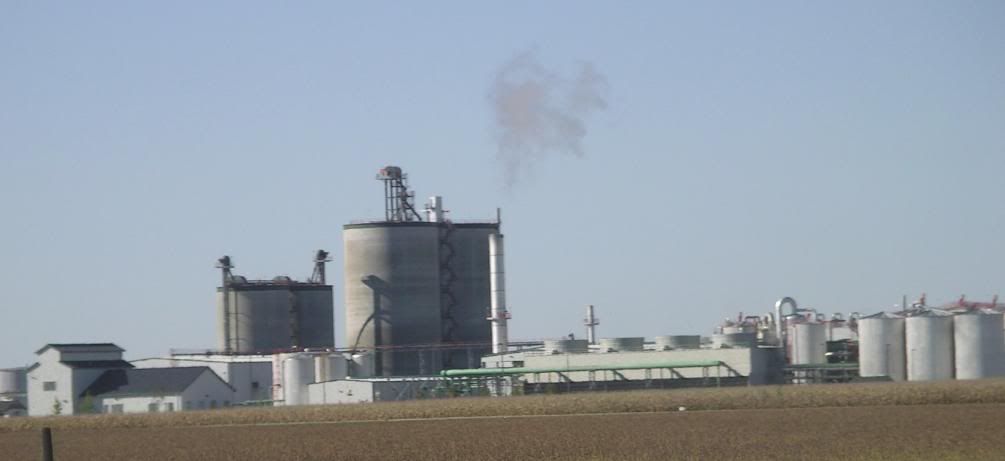
Above, is a photo that I took of a rural corn ethanol plant near the Kansas-Nebraska border.
Remember the flooding along the Missouri and Red Rivers, the derecho winds in Iowa and Nebraska which flattened corn fields for miles, the high night time temperatures in Iowa during tasseling time, the hundred-year drought in Texas, rain, rain, and more rain in Ohio, and all of the other headlines suggesting corn yields could end up low this year? Everyone was nervous with corn carryover stocks at dangerously low levels. Despite all of that doom and gloom during the 2011 corn growing season, the USDA summed the season up like this in their December World Agricultural Supply and Demand Estimates (WASDE) report:
"Weather was generally favorable for this year’s crop."If there is one thing that this country knows how to do, through hell and high water, it's grow corn.
Since we are near the end of the year, I decided to get out my calculator and look at the amount of corn being burned in our gas tanks, to see if it has changed much from last year.
It hasn't.
Here are the latest percentages of corn being turned into ethanol domestically and globally, based upon the last WASDE report data:
- U.S. corn crop being turned into ethanol: 40.6%
- Percent of the global corn crop being turned into ethanol here in the U.S.: 14.6% (Note that this doesn't include corn ethanol being made outside of the U.S.)
"About 3% of the world #corn supply is used in producing #USA #ethanol. #renewable."This 15% statistic isn't widely known, and no doubt a 3% figure from a number of year's ago is still being thrown around.
The interesting thing that has changed significantly are our corn export numbers. They are down 20% in two years! We previously boasted that we provided half of the world's corn for the global export market. As other nations ramp up production, our corn is no longer the cheapest corn available to the world. We are using twice as much corn to produce ethanol as we are exporting.
Plus, we are also exporting corn ethanol and Distiller's Dried Grains with Solubles (DDGS). This year's corn ethanol exports are set to double over last year's record setting amounts.
The dollar's valuation always plays a part in our export market competitiveness but over these past two years this has not been a factor as it has held a low to average valuation during this time period.
So, then, what is contributing to our lower corn exports?
First of all, other nations have responded to higher prices by increasing their own corn production. China set a new corn production record this year. There were gains in Russia and the Ukraine regions as well.
A reason that the ethanol folks would rather ignore, however, is the fact that we are creating high domestic prices for our own corn, which makes us less competitive on the global market, a market on which we also face growing competition.
What each of us can relate to is our higher cost of food at the supermarket. Using 41% of our corn crop for ethanol makes our domestic food costs go up. More farmers are dedicating their acres to planting corn instead of wheat, barley, dry beans, oats, cotton, peanuts, and other crops. Wheat and soybeans are being substituted as feed world-wide due to high corn prices. Corn is used in feed, and high corn prices cause hardships for livestock producers. Cattle herds have been culled, turkey and poultry facilities have closed, and dairy producers are struggling while we all pay more for peanut butter.
Meats, dairy, eggs, fats and oils are all up more than 10% this year, far exceeding the core price inflation. That is not what our struggling middle class needs in this 2011 economic hard time. Talk about the ethanol industry biting the hand that feeds it. We taxpayers subsidize ethanol production, and then we pay higher food prices for what we eat.
Corn is the monoculture crop most responsible for environmental destruction across the Midwest due to high nutrient requirements and as a cause of soil erosion. Yet, since more than half of the ethanol production is owned by big agribusiness, because of the Iowa caucus, and because of the structure of our Senate, this program is loved by the many of its vested interests and has very powerful lobbyists behind it. According to Irwin and Good at the University of Illinois, it has been profitable to blend ethanol in gasoline about 70% of the time in recent years, even without the added incentive of the blenders' tax credit, so with the tax credit a great deal of profit has been made by this industry.
In the meantime, the farms are getting bigger and the younger generation continues to leave these monoculture wastelands in flyover country for regions which offer more environmental appeal and social opportunities. This policy has driven farmland prices out of the reach of any younger person that would like to begin farming, which is too bad given that the average age of the American farmer is 57.
One last thing.
There is no greater threat to global food security than biofuels production throughout the world, and a big reason is the short-sighted abuse to our soil and water resources which result from its production. There is an insatiable thirst for liquid fuels in this Anthropocene Age that can't be quenched. It is a travesty that we should produce corn ethanol as a green mandate instead of promoting energy conservation and efficiency.
——Kay McDonald
_______________________
Statistics which I used to make the percentage calculations above:
- Corn for ethanol use remains unchanged from last year at 5 billion bushels
- Total U.S. corn production: 12,310 Million Bushels
- Global corn production for 2011/12 is projected at a new record high of 867.5 million tons
